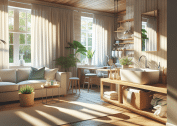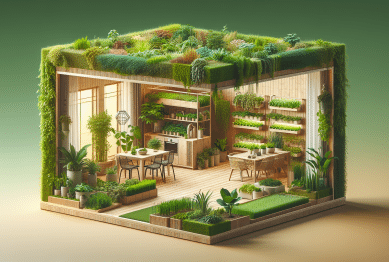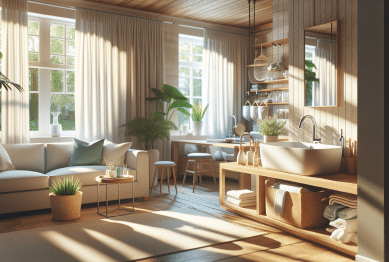Your home is more than just a place to live—it’s a reflection of who you are, your tastes, and your lifestyle. Whether you prefer modern minimalism, bohemian eclectic, or traditional elegance, your home decor should express your unique personality and support the way you live. In this article, we’ll explore how you can design a space that reflects your individual style, enhances comfort, and aligns with your daily needs.

Why Home Decor Should Reflect Your Personality
Home decor is a personal statement. It’s an opportunity to create a space that feels comfortable, inviting, and authentically “you.” When your living space reflects your personality and lifestyle, it fosters a sense of belonging and peace, making your home a sanctuary. It’s not just about choosing stylish furniture—it’s about designing a space that enhances your well-being, supports your daily routines, and expresses who you are.
Key Benefits of Personalized Home Decor
-
Creates a Sense of Belonging: A home that reflects your personality makes you feel more connected to your space.
-
Promotes Comfort and Well-Being: Personalizing your space creates an environment that is both aesthetically pleasing and functional.
-
Supports Lifestyle Needs: Home decor should align with your daily life, supporting both relaxation and productivity.
-
Increases Emotional Value: A space that reflects your style brings emotional satisfaction and enhances your mood.
For more on the psychological benefits of personalized home design, check out Psychology Today’s article on Environmental Psychology.
How to Create Home Decor That Reflects Your Personality and Lifestyle
1. Define Your Style
The first step in personalizing your home decor is identifying your style. Your style should reflect your personality and align with the way you use your space. Whether you lean toward modern, rustic, or vintage, defining your style will guide your choices and ensure your decor feels cohesive.
-
Explore Inspirations: Browse interior design websites, magazines, or Pinterest to find inspiration that resonates with you.
-
Consider Your Preferences: Pay attention to what colors, materials, and design elements appeal to you. Do you prefer sleek lines or cozy textures? Bold colors or subtle neutrals?
For more on defining your style, check out Elle Decor’s Guide to Home Design Styles.
2. Choose Colors That Represent Your Personality
Colors have a profound impact on how we feel in a space. Warm colors like red, orange, and yellow can create an energetic and welcoming atmosphere, while cool colors like blue and green promote calmness and tranquility. Select colors that reflect your mood, preferences, and lifestyle.
-
Bold Hues for Creativity: If you’re an artist or creative individual, bold and vibrant colors may inspire your work.
-
Calming Tones for Relaxation: If your goal is to create a peaceful sanctuary, opt for softer tones such as pastels, earth tones, or neutrals.
-
Accent Walls and Color Palettes: Use accent walls or complementary color schemes to add depth and interest to your space.
For more on choosing the right colors for your home, read House Beautiful’s Color Psychology Guide.
3. Incorporate Functional and Personal Furniture
Your furniture should not only be stylish but also functional for your lifestyle. Choose pieces that fit both your aesthetic preferences and your day-to-day needs. Whether you’re working from home, entertaining guests, or spending quiet evenings with family, your furniture should support these activities.
-
Multi-Functional Pieces: Consider furniture that serves more than one purpose. For example, a sofa bed or a dining table that doubles as a workspace can be ideal for small spaces or busy lifestyles.
-
Vintage or Family Heirlooms: Incorporating vintage or heirloom furniture pieces adds personality and warmth to your home while telling a story.
-
Comfort Above All: Choose furniture that prioritizes comfort. Whether it’s a plush couch or a sturdy desk chair, comfort should always be a top priority.
For more on functional and personalized furniture choices, check out HGTV’s Tips on Choosing Home Furniture.
4. Integrate Meaningful Decor and Accessories
The beauty of home decor lies in the small, meaningful touches that make your space truly your own. Personalize your decor with items that hold sentimental value or reflect your hobbies, passions, and travels.
-
Artwork and Photography: Display artwork or photographs that resonate with you, whether it’s a painting from a local artist or travel photos that capture special memories.
-
Books and Collectibles: If reading or collecting is a passion, showcase your books or collectibles in a way that adds both style and substance to your home.
-
Custom Accessories: Consider custom-made items, like monogrammed cushions, handmade ceramics, or personalized throw blankets, to give your space a unique and personal touch.
For more on personalizing your home decor, check out Apartment Therapy’s Guide to Meaningful Decor.
5. Align Decor with Your Lifestyle Needs
Your home should reflect not only who you are but also how you live. Consider your daily routine and how your home can support it. For example, if you work from home, you may want to create a dedicated office space. If you entertain often, you might prioritize an open-concept living area with a spacious dining room.
-
Home Office Setup: If you work from home, invest in ergonomic furniture, proper lighting, and organizing tools to create a functional and inspiring workspace.
-
Family-Friendly Spaces: If you have children or pets, opt for durable, easy-to-clean materials and create areas that accommodate family activities.
-
Relaxation Areas: Incorporate spaces for relaxation, such as a cozy reading nook, a calming bedroom retreat, or a spa-like bathroom.
For more on creating a home that suits your lifestyle, check out The Spruce’s Lifestyle-Oriented Home Design Ideas.
6. Sustainability in Home Decor
Sustainable design is becoming increasingly important as people seek to make more eco-conscious choices in all aspects of their lives. Incorporating sustainable home decor not only supports the environment but also contributes to a healthier, more mindful living space.
-
Eco-Friendly Materials: Opt for furniture made from sustainably sourced wood, recycled materials, or non-toxic finishes.
-
Upcycled Decor: Give new life to old furniture or accessories by upcycling or repurposing them into new pieces.
-
Energy-Efficient Features: Consider energy-efficient lighting, appliances, and insulation to reduce your carbon footprint and save on energy costs.
For more on sustainable home decor, read Sustainable Home Design Tips from Green Building Advisor.
Conclusion: Your Home, Your Personal Haven
Home decor is an expression of your individuality, and when done thoughtfully, it can enhance both the aesthetics and functionality of your living space. By reflecting your personality through color choices, furniture, accessories, and layouts, you create an environment that promotes comfort, well-being, and satisfaction. Remember, your home should be a place where you feel connected, inspired, and at ease—a true reflection of your lifestyle.
References:
-
Psychology Today. (2021). Environmental Psychology and Its Impact on Well-Being. Retrieved from https://www.psychologytoday.com/us/basics/environmental-psychology
-
House Beautiful. (2021). Color Psychology and Its Impact on Home Design. Retrieved from https://www.housebeautiful.com/
-
HGTV. (2021). Choosing Home Furniture That Reflects Your Lifestyle. Retrieved from https://www.hgtv.com/









